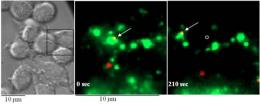Nov 15 2010
Nanoparticles show promise in solving a host of problems, from pinpointing medical diagnoses to developing alternative forms of energy and creating more durable materials.
But scientists have yet to determine exactly how these tiny particles interact in their environment, whether inside humans or in the world at large, and if those interactions can be toxic.
 Nanoparticles (shown in red) co-localized and moved with Scavenger Receptor A (green), suggesting that this receptor may play a role in mediating the interaction and fate of these particles in the certain cells.
Nanoparticles (shown in red) co-localized and moved with Scavenger Receptor A (green), suggesting that this receptor may play a role in mediating the interaction and fate of these particles in the certain cells.
In a recent study, scientists at Pacific Northwest National Laboratory discovered cellular interactions of nanoparticles at the molecular level that may lead to answers about how these particles impact living systems. Their results will appear in the journal Nanotoxicology.
As scientists begin to understand the mechanisms and molecules that influence the cellular interactions of nanoparticles carrying specific physical and chemical properties, they can better predict how nanoparticles will impact biological systems.
With a greater understanding of the cellular interactions and response to nanoparticles, government agencies and scientific associations can set realistic standards for how these particles can be used, safeguarding human health and the environment while speeding innovations in energy, medicine, and materials sciences.
The researchers focused on identifying the underlying mechanisms that govern how nanoparticles with specific properties interact with cells. Using time-lapse high-sensitivity fluorescence microscopy at EMSL, a Department of Energy scientific user facility at PNNL, the team studied amorphous silica nanoparticles in macrophages, part of the human immune system.
The high-sensitivity microscope allowed them to track individual nanoparticles in real time as the particle entered a cell, how it interacted within the live cell, and its fate. They found that the nanoparticles tended to move together with a particular macrophage protein, Scavenger Receptor A, in the cell.
When the receptor was expressed in cells that normally do not express this protein, the cells became associated with more nanoparticles. When the expression of the receptor was inhibited in the macrophages, the cells became associated with a smaller number of nanoparticles. However, the receptor's mediation was mainly associated with individual nanoparticles. When nanoparticles agglomerated and became a larger mass, as they tend to do, only a smaller fraction was found associated with the receptor.